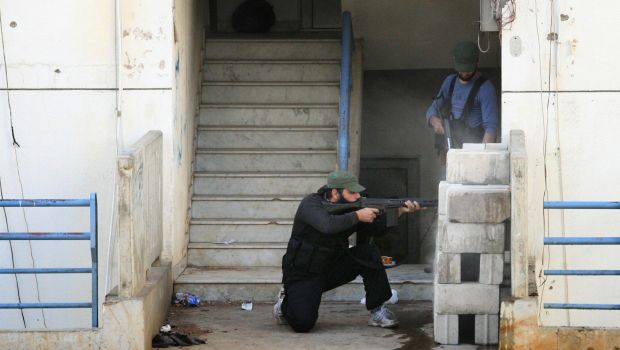No government will be able to rule Lebanon while the militias remain in power. The last few weeks witnessed a breakthrough in terms of forming a government that combined the March 8 and March 14 alliances, as some regional parties reconciled in the wake of an agreement between one of them and the United States. This coalition government and its sudden, unwarranted arrival (as per the logic of March 8 and March 14) provides an opportunity to look at what has happened throughout the continuous eight-year conflict, propelled by regional money and the blood of many. Now, we must contemplate the fundamental elements of the conflict: the parties, their quarrels and their relationships to each other, along with the causes of enduring conflict and its many faces.
Nine years have passed since the assassination of former Lebanese Prime Minister Rafik Hariri, and a gaggle of questions have been raised about the reasons behind the conflict as publicly announced by March 8 and March 14. As for Hezbollah, it has at least announced its collusion in various assassinations and the fighting in Syria, as well as its confrontation with Hamas. That and the American–Iranian agreement are all sufficient to refute their claims and reveal the weakness of their position. Are those who are fighting against Israel laying siege to Yarmouk camp and starving Palestinians?
On the other hand, it is logical to note that arms and loyalty to Iran and Syria form large obstacles to building a real, robust state in Lebanon. And what about the new “cleansing” zone built by opponents of the Future Movement, maintained by the force of arms and the bloody battles of West Beirut? What about the Future Movement’s adoption of Tripoli’s militants and leaders, whom they call “our sons”? Hezbollah waged the May 7 war in order to force their opponents into submission after years of accumulating tensions. The weakness of the Future Movement and its military preparations was revealed, despite the fact that the battles lasted for hours and used up the last of their machine guns and medium-sized weapons. The fiercest fighting that took place involved Progressive Socialist Party militants. They used extremely heavy weapons and there were casualties on both sides. It soon became clear that the militias would not be dissolved following the war, instead transforming into sleeping networks that would wake up when called upon.
Many parties involved share a common denominator. They are all&8212;except for the Future Movement and some independent groups&8212;leaders of the civil war militias that were covered by the amnesty law of 1991, as well as the 2005 law passed to release the leader of the Lebanese Armed Forces from prison after he was convicted of killing his arch-rival, Danny Chamoun, his wife, and their two children, Tariq and Julian. Walid Jumblatt, a pillar of the March 14 movement, was a leader of the socialist militias before the coup. Speaker of Parliament Nabih Berri presided over the Amal movement and Michel Aoun led the war of liberation against the Syrian government, a current ally. All of these figures are current and former foes, constantly redrawing foreign loyalties of course, but nonetheless partners in the war that claimed the lives of 200,000 Lebanese and left 17,000 missing.
The membership of these groups is mixed, and all of them possess an eternal legacy—that of being undemocratic within their own parties and sects. They work to stifle any competition utilizing money, weapons, the media and assassination threats. They control the media and state facilities, handing out public positions, services, and election donations in order to buy loyalty. They dominate audio-visual media outlets through ownership or financing. Their conception of democracy is to divide quotas among themselves, either after they’re elected or before. Elections in Lebanon take place among these parties without any real competition.
The conflict between March 8 and March 14 goes on, and the fact that it has not ended raises structural questions. Here of course, the well-known study conducted by Paul Collier and Anke Hoeffler that analyzed dozens of civil wars becomes relevant. The study identified greed as the most prominent factor in sustaining the most intractable conflicts. The Lebanese economy has not stopped growing despite the crises and wars between 2005 and 2009, and election spending between the two parties (March 8 and March 14) reached 1 billion US dollars last year, according to a BBC report. A year before that, spending for US President Barack Obama and John McCain’s presidential campaigns reached roughly the same amount. If we take into account the differences in population size, this means that Lebanon spent 80 times more than the US did. With such vast amounts of money lying around, why not end the conflict?
The fact is that spending alone is not enough and must be combined with behavioral changes, as revealed in WikiLeaks documents detailing March 14 and the clear link between Hezbollah and its Iranian funding allies. Leaders of both groups increased their wealth dramatically during the crisis, especially from the real-estate boom. Members of the Lebanese media from both sides benefited from this windfall, allowing them to live more extravagant lifestyles than those of senior media members in the Western world, as noted by a British correspondent based in Beirut.
This does not negate the fact that some stand accused of supporting the assassination of various politicians both directly and indirectly, namely, Hezbollah. But it does explain why hundreds of thousands of Lebanese citizens have retreated from Martyr’s Square since 2005, and the rigidity of the political reality in Lebanon, as well as the potential for the continuation of conflict.
Thus one national government will not be able to rule Lebanon, but it is hoped that the violence and killing happening around us will come to an end.
The counterpoint to this piece can be read here.
